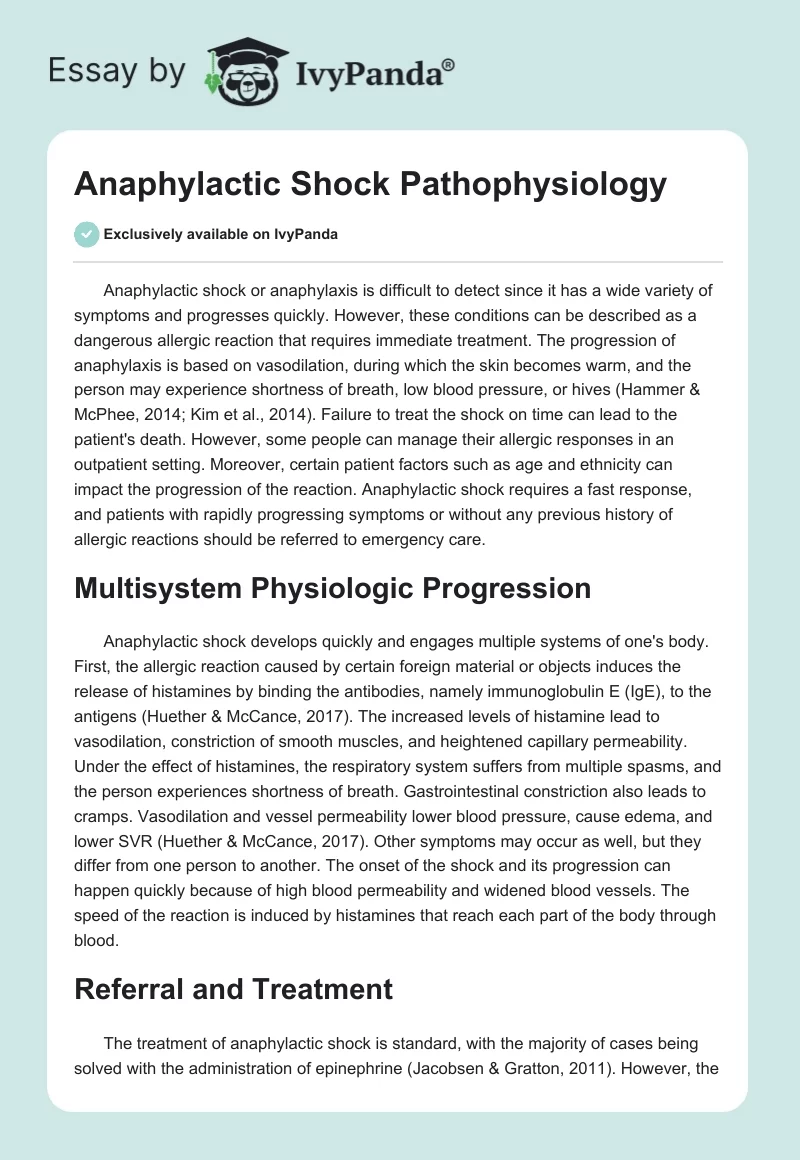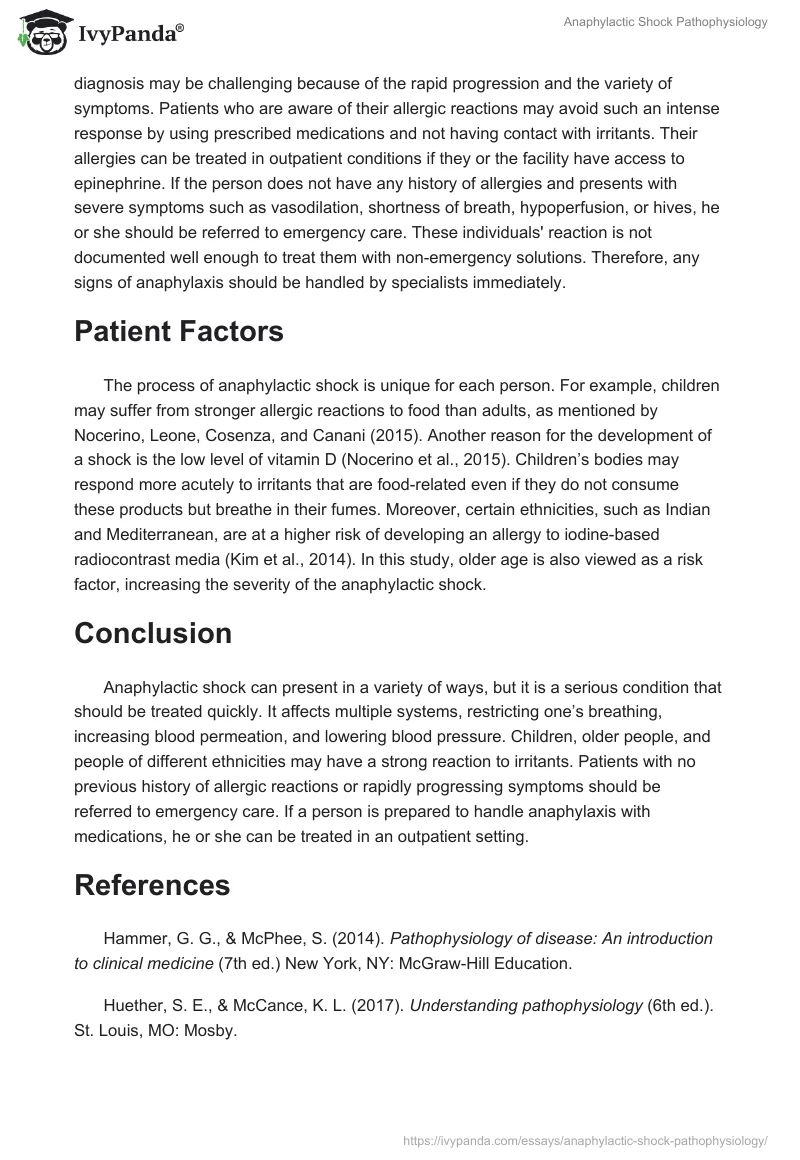Anaphylactic shock or anaphylaxis is difficult to detect since it has a wide variety of symptoms and progresses quickly. However, these conditions can be described as a dangerous allergic reaction that requires immediate treatment. The progression of anaphylaxis is based on vasodilation, during which the skin becomes warm, and the person may experience shortness of breath, low blood pressure, or hives (Hammer & McPhee, 2014; Kim et al., 2014). Failure to treat the shock on time can lead to the patient’s death. However, some people can manage their allergic responses in an outpatient setting. Moreover, certain patient factors such as age and ethnicity can impact the progression of the reaction. Anaphylactic shock requires a fast response, and patients with rapidly progressing symptoms or without any previous history of allergic reactions should be referred to emergency care.
Multisystem Physiologic Progression
Anaphylactic shock develops quickly and engages multiple systems of one’s body. First, the allergic reaction caused by certain foreign material or objects induces the release of histamines by binding the antibodies, namely immunoglobulin E (IgE), to the antigens (Huether & McCance, 2017). The increased levels of histamine lead to vasodilation, constriction of smooth muscles, and heightened capillary permeability. Under the effect of histamines, the respiratory system suffers from multiple spasms, and the person experiences shortness of breath. Gastrointestinal constriction also leads to cramps. Vasodilation and vessel permeability lower blood pressure, cause edema, and lower SVR (Huether & McCance, 2017). Other symptoms may occur as well, but they differ from one person to another. The onset of the shock and its progression can happen quickly because of high blood permeability and widened blood vessels. The speed of the reaction is induced by histamines that reach each part of the body through blood.
Referral and Treatment
The treatment of anaphylactic shock is standard, with the majority of cases being solved with the administration of epinephrine (Jacobsen & Gratton, 2011). However, the diagnosis may be challenging because of the rapid progression and the variety of symptoms. Patients who are aware of their allergic reactions may avoid such an intense response by using prescribed medications and not having contact with irritants. Their allergies can be treated in outpatient conditions if they or the facility have access to epinephrine. If the person does not have any history of allergies and presents with severe symptoms such as vasodilation, shortness of breath, hypoperfusion, or hives, he or she should be referred to emergency care. These individuals’ reaction is not documented well enough to treat them with non-emergency solutions. Therefore, any signs of anaphylaxis should be handled by specialists immediately.
Patient Factors
The process of anaphylactic shock is unique for each person. For example, children may suffer from stronger allergic reactions to food than adults, as mentioned by Nocerino, Leone, Cosenza, and Canani (2015). Another reason for the development of a shock is the low level of vitamin D (Nocerino et al., 2015). Children’s bodies may respond more acutely to irritants that are food-related even if they do not consume these products but breathe in their fumes. Moreover, certain ethnicities, such as Indian and Mediterranean, are at a higher risk of developing an allergy to iodine-based radiocontrast media (Kim et al., 2014). In this study, older age is also viewed as a risk factor, increasing the severity of the anaphylactic shock.
Conclusion
Anaphylactic shock can present in a variety of ways, but it is a serious condition that should be treated quickly. It affects multiple systems, restricting one’s breathing, increasing blood permeation, and lowering blood pressure. Children, older people, and people of different ethnicities may have a strong reaction to irritants. Patients with no previous history of allergic reactions or rapidly progressing symptoms should be referred to emergency care. If a person is prepared to handle anaphylaxis with medications, he or she can be treated in an outpatient setting.
References
Hammer, G. G., & McPhee, S. (2014). Pathophysiology of disease: An introduction to clinical medicine (7th ed.) New York, NY: McGraw-Hill Education.
Huether, S. E., & McCance, K. L. (2017). Understanding pathophysiology (6th ed.). St. Louis, MO: Mosby.
Jacobsen, R. C., & Gratton, M. C. (2011). A case of unrecognized prehospital anaphylactic shock. Prehospital Emergency Care, 15(1), 61-66.
Kim, M. H., Lee, S. Y., Lee, S. E., Yang, M. S., Jung, J. W., Park, C. M.,… Kang, H. R. (2014). Anaphylaxis to iodinated contrast media: Clinical characteristics related with development of anaphylactic shock. PLoS One, 9(6), e100154.
Nocerino, R., Leone, L., Cosenza, L., & Canani, R. B. (2015). Increasing rate of hospitalizations for food-induced anaphylaxis in Italian children: An analysis of the Italian Ministry of Health database. Journal of Allergy and Clinical Immunology, 135(3), 833-835.


